

Reviewing the Samsung Odyssey G9: the ultimate gaming monitor
Samsung's Odyssey G9 is unique. I've already tested some 49-inch super ultra-wide monitors. But none of them come close to what the G9 has to offer: the best and most complete gaming experience yet.
The specs of the Odyssey G9 make any gamer get excited. It's the first dual-quad high-definition monitor to offer 240 Hz, a 1 ms response time, HDR1000 and HDR10+, G-Sync, FreeSync Premium Pro and 1000R curvature in one. Here are the most important specs:
- Resolution, size and aspect ratio: 5120x1440 (DQHD) over 49 inches in a 32:9 format.
- Curved: 1000R of curvature.
- Screen technology: VA.
- Refresh rate: 240 Hz.
- Response time (grey to grey): 1 ms.
- Input delay: 2 ms.
- Brightness: 1000 cd/m2.
- Depth of colour: 10 bit / HDR1000 and HDR10+.
- Colour space coverage: 125 per cent sRGB and 95 percent DCI-P3.
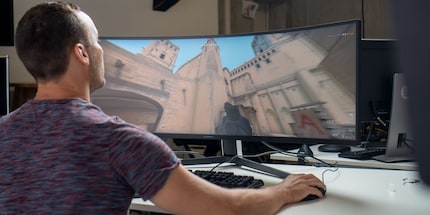
Samsung have chosen VA as their screen technology. VA panels offer high contrast, natural colours and wide viewing angles. On the other hand, response times tend to be higher than with TN panels. However, advances in technology have narrowed this gap, and Samsung is now offering a response time of 1 millisecond for the G9. In terms of backlighting, the model offers ten local dimming zones.
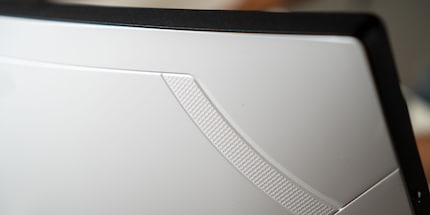
I really like the design of this monitor. You don't come across white models that often. One thing that immediately caught my eye was the «Infinity Core Lighting Design». That's several LED rings mounted on the back of the monitor. Rather reminiscent of Iron Man's arc reactor. You can choose between 52 colours and five different lighting effects. A shame you don't get to see it when you're gaming.
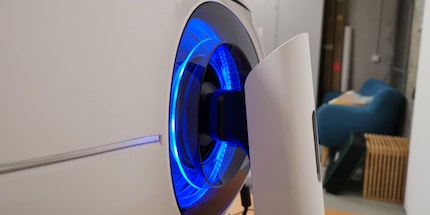
Connections and use
To get the full benefit out of the G9, connect it via DisplayPort. HDMI can't get above 60 Hz. The monitor has the following connections:
- Two USB 3.0 type A downstream ports.
- One HDMI type A 2.0.
- Two DisplayPort 1.4 ports.
- Headphones.
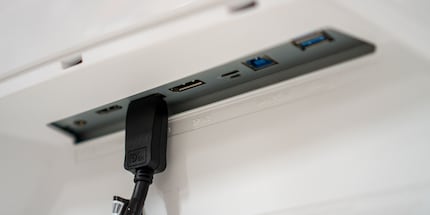
There's no USB-C. All cables can be hidden in the stand and a connection cover makes them (almost) disappear completely. The stand also functions as a headset holder. Although the headphones are nicely hidden behind the monitor, this also makes them harder to reach. Samsung specifies a 108 W power consumption. For comparison: digitec's current best-selling monitor has a power consumption of only 46.80 W. The G9 is pretty intense.
Thankfully, the monitor can be adjusted in height. You can also turn and tilt it. You'll surely find the right settings to suit your needs. You can also mount the G9 on a wall.
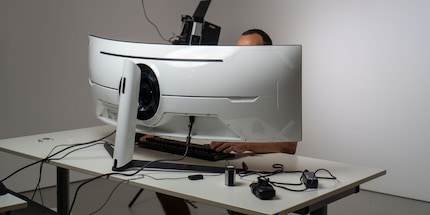
The Odyssey G9 can be operated with a single button, which doubles up as a joystick. These hybrid systems can lead to fiddly controls, yes. Nevertheless, the G9 handles it excellently. The joystick is indeed a joy to use.
If you pull it forward, you can adjust the volume, and if you push it back, you can adjust the image settings such as brightness, sharpness and contrast. If you go left or right, you choose the source. You can access the main menu by simply pressing the button. Here you'll find the default settings: the refresh rate, Adaptive Sync, picture settings, colour modes, PIP/PBP and Infinity Core Lighting controls. All in all, the menu is clear and easy to navigate.
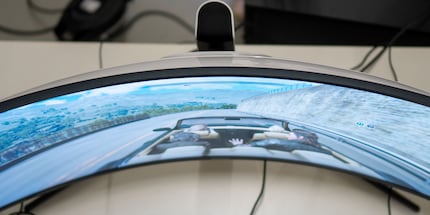
Image quality
The monitor is factory calibrated and offers different colour modes. First of all, I used the Eizo monitor test to get an idea of the quality. As you would expect from a monitor in this price range, I didn't notice any pixel errors. The image was homogeneous, the colour distances were differentiated and the gradient was even.
The x-rite i1Display Pro spectrometer measured the monitor. I found that the monitor is very evenly illuminated in the upper two thirds. Towards the bottom, however, the brightness decreases.
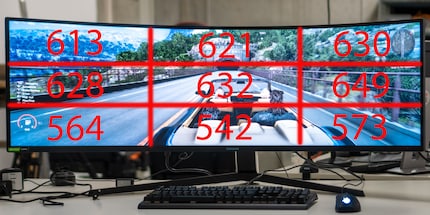
You won't see this difference with the naked eye, but over 100 nits is a lot. I also didn't measure the 1000 nits required for a DisplayHDR-1000 certification. Still, this is often the case, as this value only needs to be reached for a fraction of a second. Our spectrometer only reads constant values. At over 600 nits, the G9 is one of the brightest monitors I've ever measured. The static contrast is around 1625:1. This doesn't correspond to the promised 2500:1, but is probably also due to peak brightness, which I can't measure with our spectrometer.
I measured the following values for colour space coverage:
- 99.7 per cent sRGB.
- 87.9 per cent Adobe RGB.
- 90.8 per cent DCI P3.
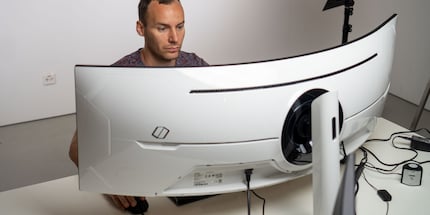
This also doesn't correspond to the values on the data sheet. Nevertheless, these are very good values, so photographers and video editors can also work with the G9. By the way, I've never measured values with our spectrometer that correspond to those of the manufacturer. My readings are always inferior. That's because our company tests in real scenarios and manufacturers test in laboratories.
Gaming, what we're all here for
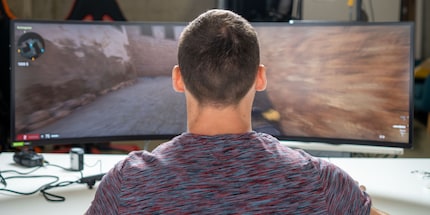
You don't need a monitor like the G9 for work. But you could just fine if you wanted to. However, it only shows its true quality when gaming. To see this high quality, your game must support a 32:9 format, something not all games do. Here you'll find a relatively well sorted list. In order to benefit from the high refresh rate, I first start «CS:GO» and set the monitor to 240 Hz. I may be the worst shooter player in the world, but thanks to the high refresh rate, I don't get any lag and hit my opponents more reliably than at a lower refresh rate. Ghosting is also not detectable.
G-Sync also makes itself felt: there's no screen tearing whatsoever. To benefit from HDR, I start «Final Fantasy XV». Wow, Eos looks even more impressive in Super Ultra Wide and with HDR1000. I could lose myself in it for hours. Nevertheless, I did notice a weakness here: when driving through a tunnel with the Regalia, slight backlight bleeding is visible in darker areas. You'll definitely notice that Samsung only uses ten local dimming zones. For TVs, Samsung uses a few more zones. Unfortunately, I couldn't take a photo with backlight bleeding, but it’s there.
In order to let the enormous 1000R curvature envelop me, I booted up «Thumper». The game is perfect for VR, and the G9 has a similar immersive effect. I feel really involved in the game, forgetting everything around me. This is definitely the greatest strength of the G9: immersion. Gaming like this really is amazing.
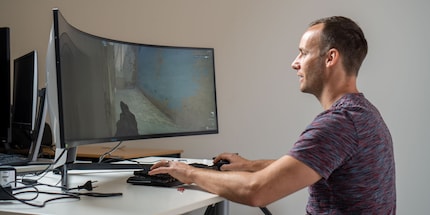
Conclusion: an awesome screen at a fair price
Even though I only had a few hours with the Odyssey G9, I didn't want to give it up. From design to functions to picture quality – this monitor is amazing. Only the light backlight bleeding has to be criticised. In most cases, however, you won't notice this and your gaming experience won't be spoiled.
For a monitor like the G9 to make sense, you'll need a decent gaming computer and compatible games. To really benefit from the high refresh rate, you should already have a 2080 Super and a modern processor. When comparing the price of the Odyssey G9 with other models, it seems like a good option: 1650 bucks is a lot of money, but considering its features and quality, the value for money is excellent. If I had the spare change and the space on my office desk, I'd immediately snap it up.

From big data to big brother, Cyborgs to Sci-Fi. All aspects of technology and society fascinate me.



